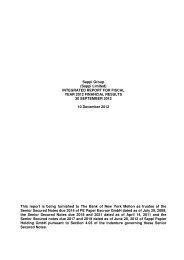2007 Annual Report - Sappi
2007 Annual Report - Sappi
2007 Annual Report - Sappi
You also want an ePaper? Increase the reach of your titles
YUMPU automatically turns print PDFs into web optimized ePapers that Google loves.
Notes to the group annual financial statements continued<br />
for the year ended September <strong>2007</strong><br />
2. Accounting policies continued<br />
including the results of remedial investigation/feasibility studies<br />
(“RI/FS”). In evaluating any disposal site environmental<br />
exposure, an assessment is made of the company’s potential<br />
share of the remediation costs by reference to the known or<br />
estimated volume of the company’s waste that was sent to the<br />
site and the range of costs to treat similar waste at other sites<br />
if a RI/FS is not available.<br />
2.3.4 Financial instruments<br />
Items which are treated under other accounting standards are<br />
not treated as financial instruments, under IAS 32 and IAS 39.<br />
(i) Initial recognition<br />
Financial instruments are recognised on the balance sheet<br />
when the group becomes a party to the contractual provisions<br />
of a financial instrument. All purchases of financial assets that<br />
require delivery within the time frame established by regulation<br />
or market convention (‘regular way’ purchases) are recognised<br />
at transaction date.<br />
(ii) Initial measurement<br />
All financial instruments are initially recognised at fair value plus<br />
transaction costs that are incremental to the group and directly<br />
attributable to the acquisition or issue of the financial asset or<br />
financial liability except for those classified as ‘fair value through<br />
profit or loss’.<br />
Financial instruments carried at fair value through profit or loss<br />
are measured at fair value on transaction date. All transaction<br />
costs are immediately written off in the income statement.<br />
(iii) Subsequent measurement<br />
Subsequent to initial measurement, financial instruments are<br />
either measured at fair value or amortised cost, depending on<br />
their classification:<br />
• Financial assets and financial liabilities at fair value<br />
through profit or loss<br />
Financial instruments at fair value through profit or loss consist<br />
of items classified as held for trading.<br />
Trading instruments are financial assets or financial liabilities that<br />
were acquired or incurred principally for the purpose of sale or<br />
repurchase in the near term, form part of a portfolio with a<br />
recent actual pattern of short-term profit-taking or are<br />
derivatives that do not form part of a designated and effective<br />
hedging relationship.<br />
• Non-trading financial liabilities<br />
All financial liabilities, other than those at fair value through profit<br />
or loss, are classified as non-trading financial liabilities and are<br />
measured at amortised cost.<br />
• Held-to-maturity financial assets<br />
Held-to-maturity financial assets are measured at amortised<br />
cost, with interest income recognised in profit or loss for<br />
the period.<br />
The group does not presently have any held to maturity<br />
financial assets.<br />
• Loans and receivables<br />
Loans and receivables are carried at amortised cost, with<br />
interest revenue recognised in profit or loss for the period. The<br />
majority of the group’s receivables are included in the loans and<br />
receivables category.<br />
• Available-for-sale financial assets<br />
Available-for-sale financial assets are measured at fair value,<br />
with fair value gains and losses recognised directly in equity<br />
along with the associated deferred taxation. Any foreign<br />
currency translation gains or losses or interest revenue, measured<br />
on an effective-yield basis, are removed from equity to the<br />
income statement on debt instruments when they arise.<br />
When available-for-sale equity instruments are determined to<br />
be impaired to the extent that the fair value declines below its<br />
original cost, the resultant losses are recognised in profit or loss.<br />
(iv) Embedded derivatives<br />
Certain derivatives embedded in financial and non-financial<br />
instruments, are treated as separate derivatives and recognised<br />
on a standalone basis, when their risks and characteristics are<br />
not closely related to those of the host contract and the host<br />
contract is not carried at fair value, with unrealised gains and<br />
losses reported in profit or loss.<br />
(v) Derecognition<br />
All financial assets and financial liabilities are derecognised when<br />
the group commits to selling a financial asset or redeeming a<br />
financial liability.<br />
The group derecognises a financial asset when:<br />
• the contractual rights to the cash flows arising from the<br />
financial asset have expired or have been forfeited by the<br />
group; or<br />
78<br />
sappi limited | 07 | annual report
















